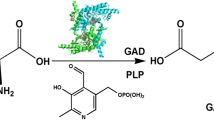Abstract
Bacillus subtilis CGMCC 0833 is a poly(γ-glutamic acid) (γ-PGA)-producing strain. It has the capacity to tolerate high concentration of extracellular glutamate and to utilize glutamate actively. Such a high uptake capacity was owing to an active transport system for glutamate. Therefore, a specific transport system for l-glutamate has been observed in this strain. It was a novel transport process in which glutamate was symported with at least two protons, and an inward-directed sodium gradient had no stimulatory effect on it. K m and V m for glutamate transport were estimated to be 67 μM and 152 nmol−1 min−1 mg−1 of protein, respectively. The transport system showed structural specificity and stereospecificity and was strongly dependent on extracellular pH. Moreover, it could be stimulated by Mg2+, NH +4 , and Ca2+. In addition, the glutamate transporter in this strain was studied at the molecular level. As there was no important mutation of the transporter protein, it appeared that the differences of glutamate transporter properties between this strain and other B. subtilis strains were not due to the differences of the amino acid sequence and the structure of transporter protein. This is the first extensive report on the properties of glutamate transport system in γ-PGA-producing strain.







Similar content being viewed by others
Abbreviations
- γ-PGA:
-
Poly(γ-glutamic acid)
- ∆p:
-
Proton motive force
- ∆pNa:
-
Sodium gradient
- ∆pH:
-
Transmembrane proton gradient
- ∆Ψ:
-
Transmembrane electrical potential
References
Shih, I. L., & Van, Y. T. (2001). Bioresource Technology, 79, 207–225.
Sung, M. H., Park, C., Kim, C. J., Poo, H., Soda, K., & Ashiuchi, M. (2005). Chemical Record, 5, 352–366.
Xu, H., Jiang, M., Li, H., Lu, D., & Ouyang, P. (2005). Process Biochemistry, 40, 519–523.
Wu, Q., Xu, H., Xu, L., & Ouyang, P. (2006). Process Biochemistry, 41, 1650–1655.
Shi, N., Xu, H., Yao, J., & Wang, J. (2007). The Chinese Journal of Process Engineering, 7, 145–148.
Birrer, G. A., Cromwick, A., & Gross, R. A. (1994). International Journal of Biological Macromolecules, 16, 265–275.
Cromwick, A. M., & Gross, R. A. (1995). International Journal of Biological Macromolecules, 17, 259–267.
Ko, Y. H., & Gross, R. A. (1998). Biotechnology and Bioengineering, 57, 430–437.
Kunioka, M. (1995). Applied Microbiology and Biotechnology, 44, 501–506.
Jung, H., Pirch, T., & Hilger, D. (2006). Journal of Membrane Biology, 213, 119–133.
Veenhoff, L. M., Heuberger, E. H. M. L., & Poolman, B. (2002). Trends in Biochemical Sciences, 27, 242–249.
de Vrij, W., Bulthuis, R. A., van Iwaarden, P. R., & Konings, W. N. (1989). Journal of Bacteriology, 171, 1118–1125.
Peddie, C. J., Cook, G. M., & Morgan, H. W. (1999). Journal of Bacteriology, 181, 3172–3177.
Tolner, B., Poolman, B., & Konings, W. N. (1992). Molecular Microbiology, 6, 2845–2856.
Heyne, R. I. R., de Vrij, W., Crielaard, W., & Konings, W. N. (1991). Journal of Bacteriology, 173, 791–800.
Tolner, B., Ubbink-kok, T., Poolman, B., & Konings, W. N. (1995). Journal of Bacteriology, 177, 2863–2869.
Bradford, M. M. (1976). Analytical Biochemistry, 72, 248–254.
Konings, W. N., Bisschop, A., & Daatselaar, M. C. C. (1972). FEBS Letters, 24, 260–264.
Goto, A., & Kunioka, M. (1992). Bioscience, Biotechnology, and Biochemistry, 56, 1031–1035.
Jacobs, M. H. J., Driessen, A. J. M., & Konings, W. N. (1995). Journal of Bacteriology, 177, 1812–1816.
Acknowledgment
This work was supported by the National Basic Research Program of China (973 Program, 2007CB714304).
Author information
Authors and Affiliations
Corresponding author
Rights and permissions
About this article
Cite this article
Wu, Q., Xu, H., Zhang, D. et al. A Novel Glutamate Transport System in Poly(γ-Glutamic Acid)-Producing Strain Bacillus subtilis CGMCC 0833. Appl Biochem Biotechnol 164, 1431–1443 (2011). https://doi.org/10.1007/s12010-011-9223-1
Received:
Accepted:
Published:
Issue Date:
DOI: https://doi.org/10.1007/s12010-011-9223-1




